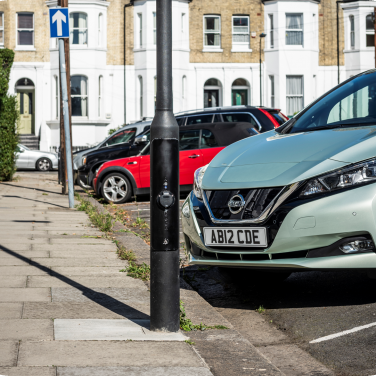The UK Government recently announced it would double available funding for on-street electric car charge points, to £2.5 million. The extra funding will contribute to the installation of over 1000 on-street electric vehicle (EV) charge points, making them more accessible to residents without off-street parking.
This follows the Government’s other news that it aims to ensure all new homes in the UK are built with the provision of EV charge points, as a world first. With a target to drive down the UK’s combined emissions to net-zero by 2050, EV is certainly leading the charge in reaching this ambitious goal.
On-street EV charging
On-street EV charging is becoming more and more available throughout England. This is, in many ways, thanks to the on-street residential charge point scheme that was launched in 2017. It aims to help local authorities install charge points, which can be integrated within existing street furniture, like lampposts, to give residents without off-street parking better access to charging infrastructure for electric cars.
Since launch, the scheme has seen 16 local authorities adapt existing infrastructure to accommodate, or prepare for, the installation of 1,200 charge points. Ultimately, this is in a bid to meet growing demand and encourage more people to purchase electric cars, by making it easier to charge their cars when they are at home, regardless of access to private parking.
Why street lighting?
There are a number of reasons why the lamppost is in the spotlight for EV charging. It is existing infrastructure, ubiquitous and common throughout most urban spaces. Streetlights are already connected to a power supply and, in residential areas especially, where space is at a premium it makes sense to utilise street furniture that has already been installed, rather than further adding to street clutter.
Of course a key reason that EV charging facilities are being retrofit into streetlights, is that it is significantly cheaper than new on-street charge points and their connection to the power grid. This, combined with the drive for EV take up where more electric cars are anticipated on the street, means there must be a charging infrastructure in place that can support it. Since pavements don’t have the capacity to accommodate additional applications, streetlights hold the answer.
Transforming the streetlight
In order to make streetlights multi-purpose assets, providing both illumination and charging facilities, the electrical infrastructure within the lighting column itself must be adapted. Although streetlights are already connected to an electricity supply, local authorities have to make the transition from private power supply to public access. Therefore, there are safety considerations, as well as those of accommodating componentry.
There are a number of companies throughout the UK helping Local Authorities transform existing residential street lighting schemes, into EV charging networks. However, where their expertise is in EV, they must work in collaboration with street lighting specialists to ensure lampposts are safe for public access.
Multi-purpose street furniture
Conventional street lighting schemes are powered from the ground-up, with supply to individual lighting columns coming from the Distribution Network Operator (DNO) into the bottom of the column. This supply is then isolated and controlled to ensure enough power is consistently fed through to the luminaire. Since the bottom of the column is at street level, it is here where EV charging solutions are usually integrated.
This can be done through simply integrating a secondary supply isolator within the street lighting column, which is able to manage and protect the current. It is important to keep the supply to the luminaire and the charge point separate to ensure continual operation, should either fail or overload. Additionally, when upgrading streetlights for EV charging, there are a number of regulations to consider such as the IET Code of Practice for Electrical Vehicle Charging Equipment Installation. Working with a street lighting specialist that is approved by DNOs throughout the UK, will ensure that street lighting infrastructure is compatible and in line with industry standards.
Adapting power infrastructure
As more and more street lighting columns are converted into on-street EV charging points, it’s vital to understand the changing demand in electricity overall. As incentives drive the increase of electric cars on our streets and roads, the supporting electrical infrastructure should also be looked at.
There is now more focus on the decentralisation of power supply, as well as the provision of electricity substations that use energy from more sustainable sources, rather than a central point. By sourcing power from a local level, rather than a national supply, the evolution of electric vehicles can be more closely supported as peaks in demand are easier to trace, which can help to inform local authorities of their energy requirements.
When looking at electric vehicles as a way to drive down emissions, we must look at the concept through a single lens. Of course, increasing EV uptake is a step-change in the way we tackle the climate crisis, however in order for its uptake to be sustainable there are more steps to take throughout the entire ecosystem, if we are to reach our destination of net-zero by 2050.
Find out how Lucy Zodion is leading the charge in EV charging infrastructure, here.


